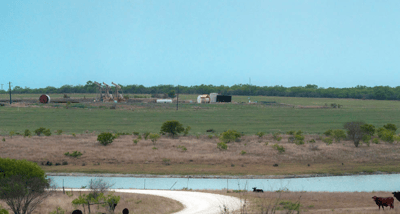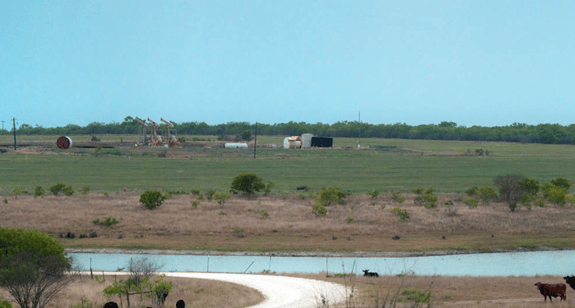 The Austin Chalk formation is well known historically for being a challenging play. The play runs in a crescent shape from South Texas through East Texas and into Central Louisiana. It is a hybrid cross between conventional fractured carbonate reservoirs and unconventional carbonate matrix reservoirs. Although the characteristics of the chalk are relatively similar across the play, there is significant variability in its depth and thickness, resulting in a wide range of production strategies.
The Austin Chalk formation is well known historically for being a challenging play. The play runs in a crescent shape from South Texas through East Texas and into Central Louisiana. It is a hybrid cross between conventional fractured carbonate reservoirs and unconventional carbonate matrix reservoirs. Although the characteristics of the chalk are relatively similar across the play, there is significant variability in its depth and thickness, resulting in a wide range of production strategies.
Austin Chalk's Challenges
The Austin Chalk developed a reputation for high temperatures and mud losses. Wells drilled horizontally into the naturally-fractured chalk formation are always full of surprises. Cutting into an unexpected fracture can result in a kick if overpressured or losses if not. Onsite drilling fluids engineers must be on alert and ready to respond at a moment’s notice.
Common drilling challenges in the Austin Chalk include:
- High bottomhole temperatures;
- Mud losses due to natural fractures;
- Drilling issues related to long laterals; and
- Hole cleaning, torque and drag reduction, and maintaining high rates of penetration.
Even with its challenges, the Austin Chalk has reemerged as a valuable play due to new technology and its potential for profitability. Its proximity to the Gulf Coast benefits from adequate midstream infrastructure, which cuts initial costs. Additionally, product pricing in the region is currently close to LLS.
History of the Austin Chalk
The Austin Chalk has a long history in oil and gas production, starting in the early 20th century. First discovered in the 1920s, the Austin Chalk experienced many boom periods.
Significant production in the Austin Chalk began in the 1950s with vertical wells tapping into its fractures. Steady production in the play continued into the 1960s. Then, in 1973, it was hydraulically fractured for the first time, drastically increasing production through the 1980s and 1990s. This level of activity lasted until the underlying Eagle Ford Shale became the industry’s darling.
For the following decade, most in the industry thought the Austin Chalk had no more to give. However, emerging technology and more knowledge of the play sparked new interest. As a result, today, producers are once again creating returns from the Austin Chalk in line with those of the Eagle Ford, Bakken, and Permian Basin.
Record Interest in the Austin Chalk
Today, operators are tapping into the natural fractures and taking advantage of the matrix porosity. New 3-D seismic data proves areas once considered depleted hold a surprisingly large number of untapped fractures. Untapped fractures and the porosity of the chalk formation bring big players back to the Austin Chalk.
Past challenges with the Chalk were more about a lack of knowledge. Now, operators are learning from each other, and technology continues to improve, proving that potential in the play remains.
Treadstone Energy Partners, for example, noted that while the Eagle Ford is economical, the Austin Chalk is performing much better. Operating in East Texas, the private operator picked up acreage in the Hearne Field to take advantage of its performance with success. Even old wells experienced incidental stimulation from the completion of new wells, adding even more to the production numbers, according to Treadstone.
Nearby, New Century Exploration is operating on 10,000 acres configured for development similar to Treadstone’s. Without as many natural fractures, this operator makes their own. After studying the Treadstone wells, New Century noted using more proppant resulted in better performance. The group also found that moving further away from the naturally fractured areas provides better results. In addition, a better understanding of chemical usage increased connectivity.
Recent Activity and Development
Exciting new oilfield technology and well design optimization has revitalized the Eagle Ford Shale operations. Consequently, this resurgence also put producers back onto the Austin Chalk, tapping into even more resources. Therefore, rig count and permit requests are on the rise in the region.
One of the region’s operators, SM Energy, consistently evaluated new and existing technology for best results. The SM Energy team sees Austin Chalk development optimizing their bottom line due to successful testing of development spacing and completion design optimization. While SM Energy also develops the Eagle Ford, the company views the Austin Chalk as its real revenue builder.
Using geomechanical modeling and fingerprinting plus microseismic monitoring, SM Energy can identify optimal landings and optimize drilling and completion plans. Payout on these wells is only nine months, according to the company. Existing midstream infrastructure and proximity to the Gulf Coast also enhance returns.
Success Exceeding Expectations
A well completed by Ecoark in Avoyelles Parish, Louisiana, in 2021 was estimated to exceed 1,000 bbl/d of oil. In a joint venture with BlackBrush Oil & Gas LP and GeoTerre LLC, Ecoark completed the drilling of the Deshotels 24 No.1-H well. A horizontal well with a vertical section of 4,046 ft and a lateral length of 3,799 ft, the initial test setup experienced significant downhole pressure.
With IP test rates as high as 1,000 to 1,250 bbl/d of oil, the well was also expected to produce a considerable volume of gas. The group rapidly employed a midstream carrier to connect to the wellsite. Ecoark reported optimism about the initial results of the project and its production levels. The group planned to monitor the flowback results of this well while exploring the future of more projects in the area.
White River Operating currently operates the Deshotel 24H 001. After a successful workover project to remove paraffin build-up in 2022, the well showed a 500% increase in production. With the success of the workover and the potential of new acquisitions, White River looks forward to continued success in the Austin Chalk play.
Future looks bright for Austin Chalk
While past challenges and varied results from the Austin Chalk created hesitancy for development, operators today are taking the opportunity to utilize new methods and information to revitalize the play. Still, the naturally-fractured chalk formation remains full of surprises despite the abundance of knowledge and new technologies.
At Panther, we have experience with the unique drilling challenges of the Austin Chalk. Our fluids management experts are able to recommend the correct technology for this distinct drilling environment. Learn more about our expertise in the Austin Chalk and the different areas where we operate.

